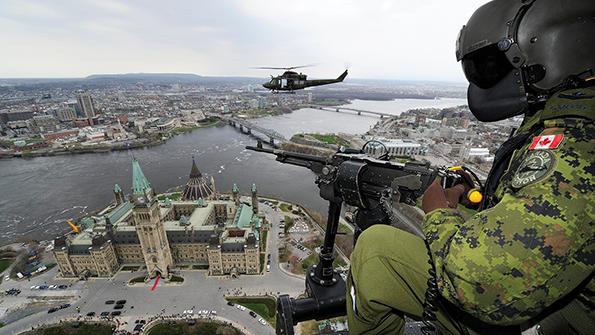This article is published in Aviation Week & Space Technology and is free to read until May 24, 2024. If you want to read more articles from this publication, please click the link to subscribe.

A replacement for Canada’s long-serving CH-146 Griffon helicopters is funded under Ottawa’s new defense plans.
Canada has pledged to spend billions more on its national defense to modernize, become a more reliable ally and counter emerging threats from Russia and China.
Plans for new tactical helicopters, an airborne early warning capability and long-range strike capabilities are on Ottawa’s shopping list. Yet much of the new defense policy—“Our North, Strong and Free”—largely commits only to exploring rather than funding these capabilities, while the onus of increasing spending will fall to future administrations over the next 20 years.
- Defense budget will be equivalent to 1.76% of GDP in 2029-30
- Reforms are planned to shorten procurement process
- Questions remain around airborne early warning aircraft plans
Furthermore, that additional funding only slightly nudges the dial toward NATO’s target of spending 2% of gross domestic product (GDP) on defense. The additional CA$8.1 billion ($5.9 billion) planned for the next five years allows for the equivalent of 1.76% of GDP by 2029-30, up from around 1.4% currently, according to figures published by the alliance. It remains unclear whether Canada will ever meet the 2% goal or has any intention of doing so.
Despite this, the U.S. appears satisfied with the plans after years of calling on its neighbor to raise defense spending. U.S. Ambassador to Canada David Cohen called the pledges the “most significant investments in defense spending in recent Canadian history.”
Perhaps more crucial, in addition to the spending pledges, Ottawa has committed to a regular four-year cycle of defense reviews and to revamping defense procurement processes that have long been mired in politicking. After all, it took more than a decade to greenlight the purchase of a new combat aircraft, Lockheed Martin’s F-35 Joint Strike Fighter.
“Previously, we sent our people out to the front lines across the world,” Canadian Prime Minister Justin Trudeau said as he announced the defense policy at Canadian Forces Base Trenton in Ontario on April 8. “We are now on the front lines of new, evolving threats,” he added, noting that adversaries’ cyberattacks go beyond traditional borders.
Trudeau told journalists that the new policy is a starting point and more is to come, as the policy outlines plans to modernize the country’s submarine capabilities, for example. But because these plans have not yet been fully defined, “we have not put the money into this calculation,” he said.
Priorities for the plan include the defense of Canada’s Arctic regions—which are seeing increased Chinese and Russian activity—as well as its involvement in North American Aerospace Defense Command (NORAD).
Among the largest pledge is CA$18 billion for a new fleet of tactical helicopters, likely to replace the country’s long-serving Bell CH-146 Griffon derivative of the Bell 412 and perhaps its Boeing CH-47/CH-147 Chinooks and Sikorsky CH-148 Cyclones. The plan describes this new fleet as a “more modern, mobile and effective tactical helicopter capability [that] may include a mix of crewed and uncrewed aircraft.”
Perhaps the most intriguing proposal is for Canada to acquire an organic airborne early warning aircraft to support NORAD and boost detection of aircraft and missiles over long distances. However, the project is only slated for CA$307 million in 2024-44, bringing into question how many—if any—such aircraft Canada could afford, given the current cost of platforms such as the Boeing E-7 Wedgetail or Northrop Grumman E-2 Hawkeye. Furthermore, Canada already partly funds and provides personnel for NATO’s Germany-based Boeing E-3 Sentry airborne early warning operation and enjoys access to those aircraft.
Aviation Week asked the Canadian National Defense Department to clarify its plans, but no response had been received at the time this article was published.
Beyond the two aircraft procurements, Ottawa seeks to acquire a satellite communications capability with worldwide coverage, purchase a long-range strike capability for the army and develop operational support hubs with airstrips in the Arctic and north. The policy documents also call for increasing missile stocks for Canada’s F-35s.
Among the aerospace projects to be explored are acquisition of standoff weapons to equip Ottawa’s F-35s and surface combatants, ground-based air defenses to protect critical infrastructure, and surveillance and armed uncrewed aircraft systems (UAS), as well as counter-UAS capabilities.
Although the documents do not say what kind of air defense systems will be considered, the move reflects the growing emphasis on such ground-based air defenses across NATO since Russia’s full-scale invasion of Ukraine in February 2022. While the Canadian Army is equipped with short-range man-portable air defense missiles, they depend on the air force to deal with threats beyond that.
Ministers are also hoping the extra spending will “strengthen the foundations” by bolstering recruitment and retention at a time when serving in the armed forces is no longer the attractive career it once was. However, the strategy does not foresee the military returning to its authorized strength of 71,500 full-time members until 2032. The plan also aims to boost Canada’s defense industry, invest in new ammunition production capabilities and support defense research and development initiatives.
Significant modernization is already in the offing for the Royal Canadian Air Force and the country’s air defense capability. In addition to the investments in NORAD announced in the summer of 2022, Canada has on order 88 F-35s, nine Airbus A330/CC-330 Multi-Role Tanker Transports, 16 Boeing P-8A Poseidon maritime patrol aircraft, 16 new or upgraded Leonardo CH-149/AW101 Cormorant search-and-rescue helicopters and 11 General Atomics Aeronautical Systems Inc. MQ-9B SkyGuardian UAS.
“This is important for the world we are in right now, and it is important to tool up the Canadian Forces with the equipment necessary,” Trudeau said.





